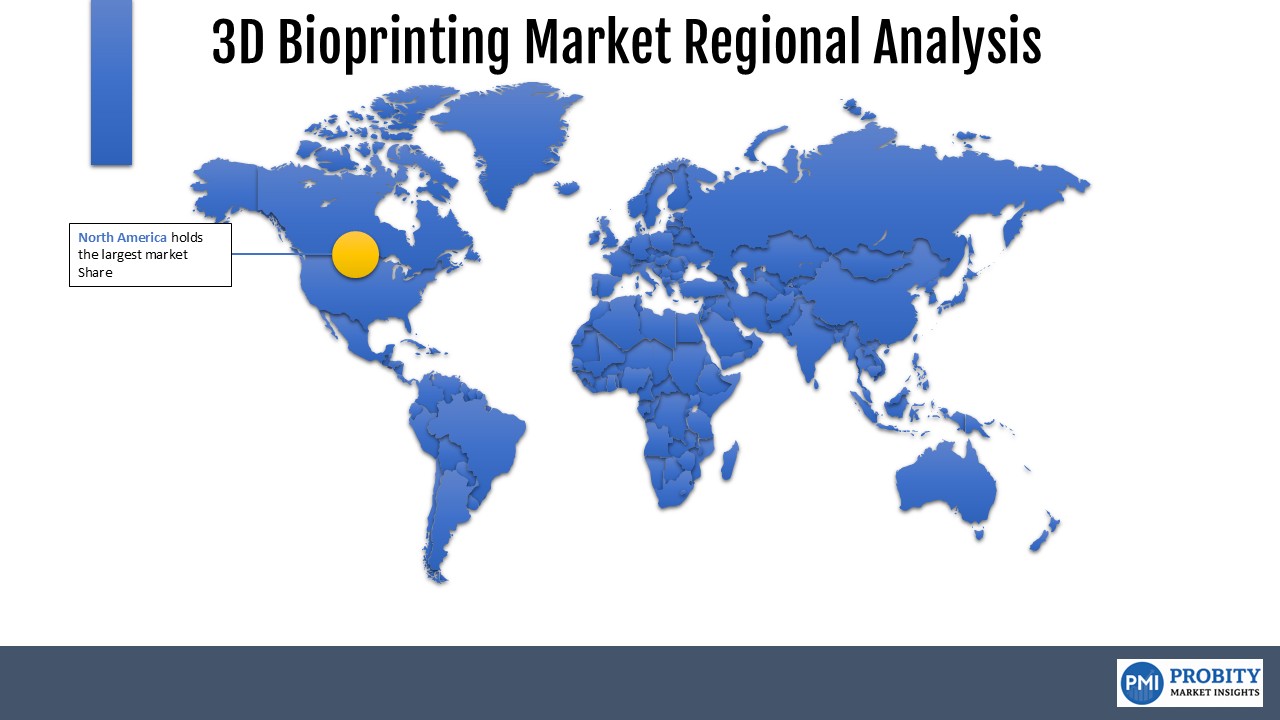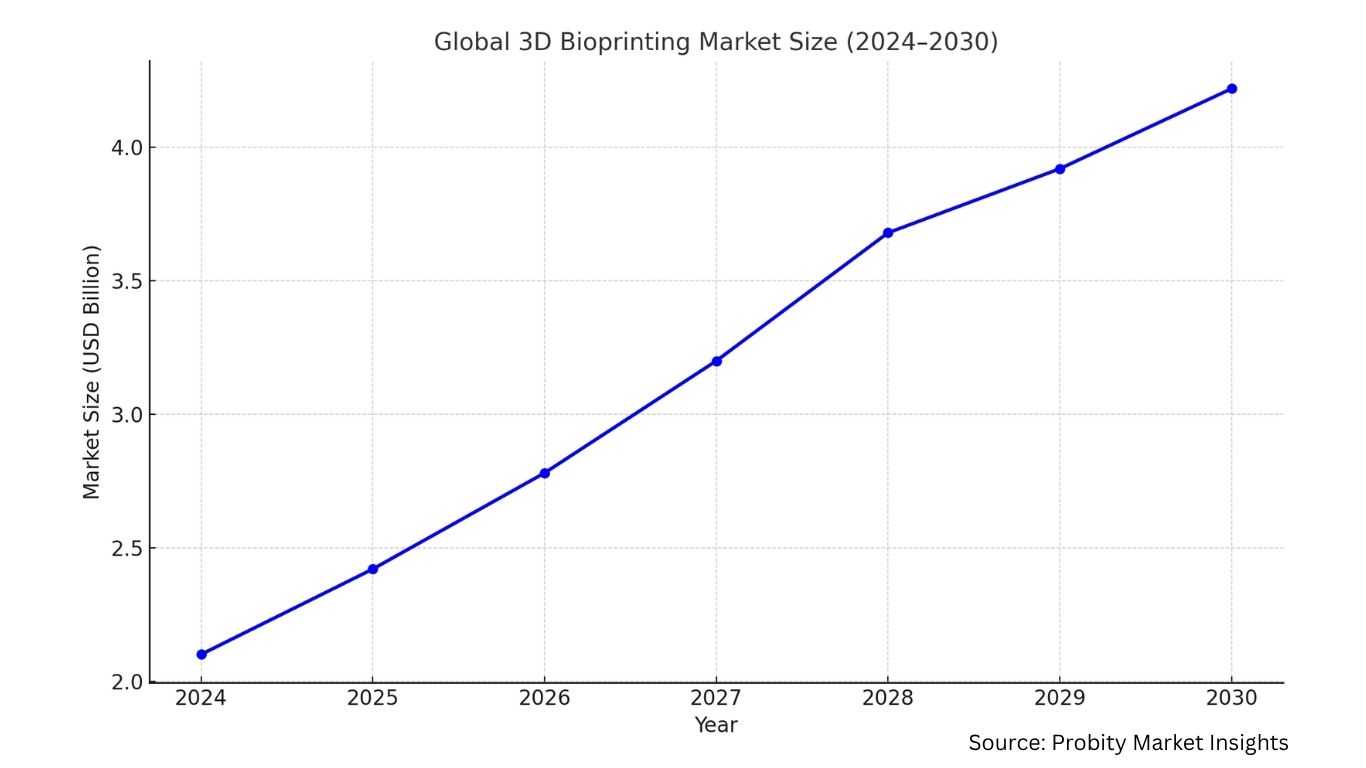3D Bioprinting Market Research Report - Industry Size, Share, Growth Analysis | Key Players, Trends & Outlook (2025 to 2033)
3D Bioprinting Market Size (2025 – 2030)
The revolutionary field of 3D bioprinting is transforming healthcare by enabling the fabrication of living tissues and organs using cutting-edge technology. This breakthrough has the potential to address critical medical challenges, such as organ shortages, personalized drug testing, and regenerative medicine. The global 3D bioprinting market was valued at USD 2.3 billion in 2024 and is projected to grow at a strong CAGR of 15.1% from 2025 to 2030, reaching an estimated USD 5.4 billion by 2030. This growth is propelled by advances in biomaterials, stem cell research, and increasing adoption in pharmaceutical and clinical applications.
3D Bioprinting Market Overview
The 3D Bioprinting Market represents a cutting-edge frontier in biomedical innovation, where 3D printing technology is utilized to fabricate biological structures using living cells, bio-inks, and hydrogels. With the capability to replicate tissues and potentially organs, 3D bioprinting is revolutionizing healthcare and research applications.
The growing demand for custom tissue engineering, rapid drug testing models, and personalized therapeutic solutions is fueling market growth. Institutions including pharmaceutical companies, academic research labs, and biotech startups are investing in bioprinting to address challenges in organ transplantation, drug toxicity testing, and complex disease modeling.
Key Market Insights
- Organ Transplant Demand: Over 100,000 patients in the U.S. alone are on transplant waiting lists as of 2024. Bioprinted tissues offer a scalable alternative.
- Government Investment: In 2023, the U.S. allocated over USD 1 billion in tissue engineering and bioprinting R&D.
- Pharmaceutical Applications: Bioprinted tissue models are projected to drive USD 1.5 billion in drug testing market value by 2028.
- Regional Dominance: North America holds a 40% market share (2024) due to robust infrastructure and early technology adoption.
- Technological Breakthroughs: Development of stem-cell-based bio-inks and scaffold-free techniques now enables 80%+ cell viability in liver tissue models.
Market Growth Drivers
1. Innovations in Biomaterials and Bio-ink Technologies
The continuous advancement in hydrogel-based and stem-cell-derived bio-inks is transforming the precision and viability of printed tissues. New crosslinking methods and nanomaterial integration are enabling the fabrication of complex and durable biological structures, improving clinical applicability and reducing rejection rates.
2. Increasing Demand for Regenerative Medicine and Transplants
Organ shortage and a surge in chronic illnesses have spurred interest in bioprinting technologies. Governments and medical institutions are focusing on fabricating patient-specific grafts and tissues, paving the way for potential whole-organ fabrication.
3. Adoption by Pharmaceutical Companies
3D bioprinting is becoming essential in drug discovery for its ability to mimic human physiology accurately. Bioprinted liver and kidney models enable advanced toxicity screening and are being validated by regulatory bodies like the FDA, accelerating drug pipelines and reducing dependency on animal testing.
Market Challenges and Restraints
1. High Cost and Technical Complexity
Capital-intensive setups, expensive bioprinters (USD 200,000+), and a lack of widespread technical expertise limit access to this technology. Challenges in vascularization and cell survival further complicate scalability.
2. Regulatory and Ethical Uncertainty
The regulatory environment is still evolving, particularly for clinical-grade tissues and organs. Ethical concerns surrounding stem cell use, IP ownership, and safety validation processes contribute to commercialization delays.
Market Opportunities
- Personalized Medicine: Patient-specific implants and drug testing models
- Skin Grafting & Burn Treatments: Bioprinted skin for clinical and cosmetic uses
- Orthopedic Implants: Bioprinted bone and cartilage replacements
- Stem-Cell Advancements: Accelerating organ viability and integration
- AI Integration: Automating material selection and enhancing precision
Market Report Coverage
|
Report Metric |
Details |
|
Market Size Available |
2024 - 2030 |
|
Base Year |
2024 |
|
Forecast Period |
2025 - 2030 |
|
CAGR |
15% |
|
Segments Covered |
By Product, Application, and Region |
|
Analyses Covered |
Global, Regional & Country, Segment, DROC, PESTLE, Porter’s Five Forces, Investment Insights |
|
Regional Scope |
North America, Europe, APAC, Latin America, MEA |
|
Key Companies Profiled |
Organovo, CELLINK, EnvisionTEC, Allevi, Aspect Biosystems, RegenHU, Poietis, Cyfuse Biomedical, 3D Systems Corp, CollPlant Biotechnologies |
Market Segmentation
By Product
- Bioprinters
- Bio-inks
- Scaffolds
- Consumables
Bioprinters lead the segment due to rising demand for precision printing of complex tissues. Continuous innovation and scalability are fueling their dominance.
By Application
- Tissue Engineering
- Drug Discovery
- Regenerative Medicine
- 3D Cell Culture
Tissue Engineering accounts for the largest market share, driven by increasing clinical and research use in fabricating organ-specific tissues.
By Region
- North America
- Europe
- Asia-Pacific
- Latin America
- Middle East & Africa
North America dominates due to advanced R&D infrastructure, favorable regulations, and presence of leading bioprinting firms.

Latest Market Trends
- AI and Machine Learning Integration: Enhancing bio-ink compatibility and predictive modeling.
- Vascularized Tissues: Microfluidics-enabled perfusion networks to improve tissue survival.
- 4D Bioprinting: Tissues that evolve in response to environmental stimuli.
- Organ-Level Replication: Efforts underway to create full kidneys and hearts using advanced stem-cell techniques.
- Commercialization of Bioengineered Tissues: Growing use of skin and liver models in preclinical drug testing.
Key Companies in the Market
- EnvisionTEC
- Allevi
- Aspect Biosystems
- RegenHU
- Poietis
- Cyfuse Biomedical
- 3D Systems Corporation
- CollPlant Biotechnologies
- Organovo
- CELLINK and more
1. INTRODUCTION
1.1 Market Definition
1.2 Study Deliverables
1.3 Base Currency, Base Year, and Forecast Periods
1.4 General Study Assumptions
2. RESEARCH METHODOLOGY
2.1 Introduction
2.2 Research Phases
2.2.1 Secondary Research
2.2.2 Primary Research
2.2.3 Econometric Modelling
2.2.4 Expert Validation
2.3 Analysis Design
2.4 Study Timeline
3. OVERVIEW
3.1 Executive Summary
3.2 Key Inferences
4. MARKET DYNAMICS
4.1 Market Drivers
4.2 Market Restraints
4.3 Key Challenges
4.4 Current Opportunities in the Market
5. MARKET SEGMENTATION
5.1 By Product
5.1.1 Introduction
5.1.2 Bioprinters
5.1.3 Bio-Inks
5.1.4 Scaffolds
5.1.5 Consumables
5.1.6 Others
5.1.7 Market Size Estimations & Forecasts (2025–2033)
5.1.8 Y-o-Y Growth Rate Analysis
5.1.9 Market Attractiveness Index
5.2 By Application
5.2.1 Introduction
5.2.2 Tissue Engineering
5.2.3 Drug Discovery
5.2.4 Regenerative Medicine
5.2.5 3D Cell Culture
5.2.6 Cosmetics & Skin Testing
5.2.7 Others
5.2.8 Market Size Estimations & Forecasts (2025–2033)
5.2.9 Y-o-Y Growth Rate Analysis
5.3 By Region
5.3.1 Introduction
5.3.2 North America
5.3.3 Europe
5.3.4 Asia-Pacific
5.3.5 Latin America
5.3.6 Middle East & Africa
5.3.7 Market Size Estimations & Forecasts (2025–2033)
5.3.8 Y-o-Y Growth Rate Analysis
6. STRATEGIC ANALYSIS
6.1 PESTLE Analysis
6.1.1 Political
6.1.2 Economic
6.1.3 Social
6.1.4 Technological
6.1.5 Legal
6.1.6 Environmental
6.2 Porter’s Five Forces Analysis
6.2.1 Bargaining Power of Suppliers
6.2.2 Bargaining Power of Consumers
6.2.3 Threat of New Entrants
6.2.4 Threat of Substitutes
6.2.5 Industry Rivalry
7. COMPETITIVE LANDSCAPE
7.1 Company Profiles (8–10 Players)
7.1.1 Organovo Holdings Inc.
7.1.2 CELLINK (BICO Group)
7.1.3 EnvisionTEC GmbH
7.1.4 Allevi Inc.
7.1.5 Aspect Biosystems Ltd.
7.1.6 3D Systems Corporation
7.1.7 Poietis
7.1.8 RegenHU
7.1.9 CollPlant Biotechnologies
7.1.10 Others
8. MARKET OUTLOOK AND INVESTMENT OPPORTUNITIES
Request Sample
Access the Insights in Multiple Formats Purchase options starting from $ 2500
Access the Insights in Multiple Formats Purchase options starting from
Access the Insights in Multiple Formats Purchase options starting from
